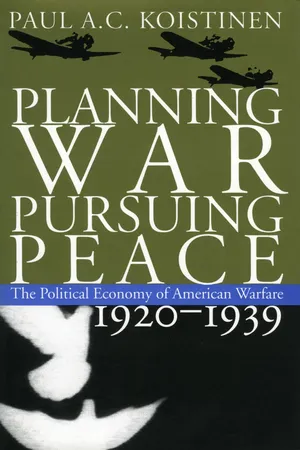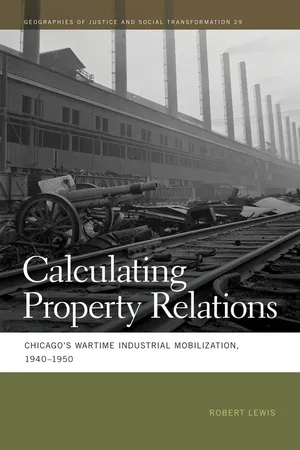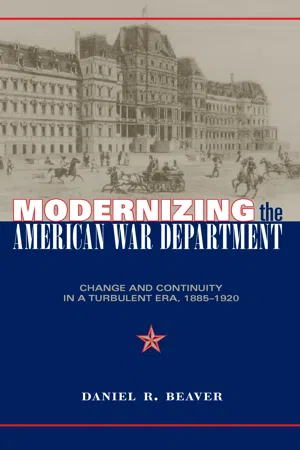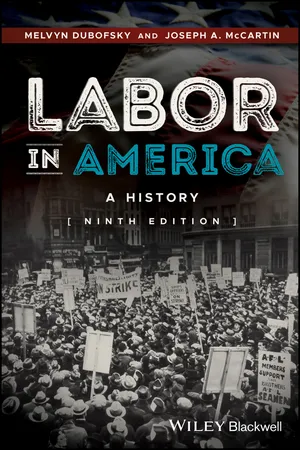History
War Industries Board
The War Industries Board was a United States government agency established during World War I to coordinate the production of war materials and ensure efficient use of resources. Led by Bernard Baruch, it played a key role in mobilizing the American economy for war production, setting production priorities, and allocating scarce resources to support the war effort.
Written by Perlego with AI-assistance
Related key terms
Related key terms
1 of 4
Related key terms
1 of 3
6 Key excerpts on "War Industries Board"
- eBook - ePub
Modern War Studies
The Political Economy of American Warfare, 1920-1939
- Paul A. C. Koistinen(Author)
- 2015(Publication Date)
- University Press of Kansas(Publisher)
PART ONEPLANNING WAR
The political economy of warfare during the interwar years was shaped largely by the War Industries Board (WIB) of World War I. In its final form, the board was a gigantic planning partnership of government and business that inextricably combined public and private interests.Worked out in various stages between 1915 and 1918, the WIB was patterned roughly after the American economy. Serving for a dollar a year or without compensation, businessmen and professionals directed the board through its commodity section–war service committee system. Commodity sections oversaw major industries or economic sectors, such as steel, chemicals, and finished products, and were staffed by businessmen on temporary government service. War service committees existed for most industries and were made up of industry representatives, trade association officials, and various experts. Unlike commodity sections, these committees were not technically a part of the WIB; they were set up only to advise commodity sections on production, priorities, and other economic mobilization functions. In actuality, however, commodity sections and war service committees usually operated as one.Although crude, the War Industries Board proved to be an effective means for harnessing the economy for war. The greatest obstacle facing the board was the War Department, the major claimant on the economy. It intensely resisted adjusting army supply operations to those of civilian agencies. The results were dire. By winter 1917–1918, the economic mobilization machinery began grinding to a halt. Under the threat of losing control over supply, the War Department was forced to adapt its economic functions to those of the WIB. Although considerable progress was made along these lines by the time of the armistice, a great deal remained to be done before America’s mobilization future was secure.Interwar planning by the army continued its adjustments to the dictates of modern warfare. Legislation passed in 1920 authorized the War Department to plan for procurement and economic mobilization. Procurement planning was intended to rationalize army supply operations so that the service could respond better during an emergency; economic mobilization planning was intended to familiarize the War Department with developments that had occurred during World War I and to help keep the nation prepared for future hostilities. The Navy Department ultimately joined in the planning, although the War Department was always in the lead. - eBook - ePub
- Ami J. Abou-bakr(Author)
- 2013(Publication Date)
- Georgetown University Press(Publisher)
New York Times , “President Names Defense Advisors.115. Cuff writes, “The very absence of formalized patterns and complicated structures afforded them a wide field for creative action.” Cuff, War Industries Board , 43.116. Cuff argues that the “vast majority of the American people were reluctant to enter World War I”; Cuff, “Bernard Baruch,” 117; Cuff, War Industries Board , 44–45.117. Baruch, American Industry , 21. Dorwart calls the WIB a “policy-centralizing clearing house and coordinating agency linking government to industry”; Dorwart, Eberstadt and Forrestal , 45.118. Baruch, American Industry , 21.119. Ibid.120. Dorwart describes the committee system: “Industrial divisions and commodity sections, each run by a director, board of experts, and government representative from the purchasing agency interested in that particular commodity, exerted control over conflicting interests. Division directors authorized and prioritized contracts. They translated central policies to private industries through regional advisors and the war service committees of the Chamber of Commerce.” Dorwart, Eberstadt and Forrestal , 45.121. Baruch, American Industry , 22.122. Ibid.123. Clarkson, Industrial America , 299.124. In addition to Baruch, the members of the WIB included Alex Legge (vice-chair), Rear Adm. F. F. Fletcher (navy representative), Major Gen. George W. Goethals (army representative), Robert S. Brookings (chair of the price-fixing committee), Edwin B. Parker (priorities commissioner), George N. Peek (commissioner of finished products), Hugh Frayne (labor representative), J. Leonard Replogle (steel administrator), L. L. Summers (technical advisor), Albert C. Ritchie (general counsel), and H. P. Ingels (secretary). Baruch, American Industry , 26; Field, Bernard Baruch , 156. For a detailed organizational chart of the WIB, see Baruch, American Industry - eBook - ePub
Calculating Property Relations
Chicago's Wartime Industrial Mobilization, 1940–1950
- Robert Lewis, Deborah Cowen, Nik Heynen, Melissa Wright(Authors)
- 2016(Publication Date)
- University of Georgia Press(Publisher)
The War Industries Board was “no more than an extension and elaboration of the regulatory mechanism the state had built up to monitor the large corporations since the late nineteenth century.” Little systematic knowledge was created. While partially successful, the state was loath to intervene in the private realm. Accordingly, by the end of the war, the federal government had little knowledge of the nation’s industrial capacity beyond a basic inventory of factories and their location. 50 The problems of industrial planning during the Great War forced the military and the federal government to reassess their options for the future. The National Defense Act of 1920 authorized the War Department to plan the economic mobilization of both the armed services and the entire wartime economy. The Industrial Mobilization Plan of 1930 became the blueprint for future wartime plans. The Special Senate Committee to Investigate the Munitions Industry in the mid-1930s outlined ways of organizing industrial mobilization. The creation of the Army and Navy Munitions Board and the Army Industrial College recognized the need for collaborative planning of war production requirements. This expansion of industrial planning during the interwar years had an impact on defense planning during World War II. The most important decisions involved producing knowledgeable military staff, linking wartime military plans to the economy, and making a survey of the nation’s industrial plants. By the time the state turned to war, the military had assembled information, among other things, about the nation’s production lines, firm locations, employment levels, and fixed capital - eBook - ePub
The Great War
1914-1918
- Ian F. W. Beckett(Author)
- 2014(Publication Date)
- Routledge(Publisher)
The same kind of transformation occurred elsewhere. In the United States, little had been done prior to April 1917 to intervene in the economy. Many elements within Wilson’s Democratic Party instinctively distrusted federal power. Coming on top of orders already placed by the Entente, the sudden demands by the War Department plunged American industry into chaos. In response, a variety of new agencies emerged, but the administration preferred incentive to outright control, with the result that industrial mobilisation was by no means centralised. The pre-war ‘preparedness’ movement had thrown up a Council of National Defense and a Civilian Advisory Commission in August 1916, intended to prepare for integration of government and business in the event of American entry to the war. It provided some basis for the new agencies. In particular, the advisory commission suggested establishing the War Industries Board (WIB) in July 1917, as a means of bringing order to the government’s purchasing system. From March 1918 the War Industries Board was headed by the Wall Street banker, Bernard Baruch.Other wartime creations included the National War Labor Board under a former president, W. H. Taft; the War Labor Practices Board, War Finance Board, and the Food Administration, which was headed by Herbert Hoover, an engineer who had been leading the London-based Commission for the Relief of Belgium (CRB). As in Britain, new creations were not automatically successful, the Emergency Fleet Corporation achieving little before the war ended, due to initial in-fighting between its head, General George Goethals, and the pro-German administrator of the Shipping Board, William Denman. The Fuel Administrator, Harry Garfield, proved unequal to a fuel crisis in the winter of 1917–18. Indeed, Garfield’s decision to shut all factories east of the Mississippi for four days in January 1918 prompted an attempt by congressional critics to vest war direction in a three-man war cabinet excluding Wilson. Wilson countered with legislation passed in May 1918 to authorise him to reorganise government agencies without consulting Congress. The same fuel crisis also brought a three-day shut down in Canada in February 1918.10 - eBook - ePub
Modernizing the American War Department
Change and Continuity in a Turbulent Era, 1885-1920
- Daniel Beaver(Author)
- 2013(Publication Date)
- The Kent State University Press(Publisher)
On February 1, 1918, Wilson requested that Baker and Baruch meet and agree to some mutually acceptable arrangement to make the WIB an effective agency to coordinate industrial support for the War Department. Baker continued to insist that the power to set program must rest with the army and suggested that the WIB ought to continue as a coordinating rather than a directing agency. Baruch convinced Baker that congressional criticism could only be quieted by forthright reform of the civilian sector of the war effort. Baker agreed that the WIB should become a “legal, authoritative, responsible, centralized agency” to expedite the military program. Moreover, it should have power, subject to the approval of the president, “to commandeer plants, products, equipment, manufacturing facilities, mines and materials” and the additional power of “distributing materials thus commandeered.” It was agreed further that the board should procure military supplies, control the industry of the country, and determine prices and compensation, thus assuring that “single representatives of War, Navy, Allied, and Shipping Boards could meet, clear their difficulties, coordinate their needs, and in consultation with the chairman of the War Industries Board submit their program for his [the chairman’s] final allocation, distribution, and judgment.”Baker sent Wilson the results of the conference the following day. It is not clear just when Wilson decided on Baruch, but when McAdoo wrote him asking that Baruch become his assistant in the railroad administration, Wilson replied that he had decided to appoint Baruch chairman of the WIB as soon as he could do so “without risking new issues on the Hill.” When the presidential letter announcing Baruch’s selection and calling for “the fullest possible co-operation of your department” arrived, Baker had left Washington on a tour of the fighting front in France. He never revealed what he thought about the appointment.18In March 1918, Baruch became chairman of the WIB with power to coordinate war manufacturing in support of the armed forces, but he was no “czar.” He often had to act without the support of Secretary Baker. His efforts were hampered by the obnoxious anti-Semitism of wartime associates such as Lovett and Judge Edwin B. Parker. Baruch did not originate the famous WIB commodity committees. The United States Chamber of Commerce, through its war service committees, had already organized the existing trade associations and was busily creating more. War Department administrators had already linked the war service committees and army supply agencies. Baruch had nothing to do with the Overman Act of May 1918, which was drafted by Judge Advocate General Crowder in February 1918, and that legislation had legalized all previous changes in the emergency war agencies and authorized the president to prosecute the war by executive order if necessary. During the summer of 1918 he was as much out of touch with political and military realities as everybody else in the Wilson war government.19 Baruch never questioned the industrial measures proposed to support the eighty-division program.20 - eBook - ePub
Labor in America
A History
- Melvyn Dubofsky, Joseph A. McCartin(Authors)
- 2017(Publication Date)
- Wiley-Blackwell(Publisher)
Nevertheless, on the whole, labor continued to support the war effort conscientiously, and the great majority of unions sought to restrain strike activity. The work time lost to strikes actually averaged only about one tenth of 1 percent of the total working time in industry as a whole and was estimated to be the equivalent of no more than one day per worker for the four war years. Many of the strikes that did occur were unauthorized “wildcat” walkouts. Their grievances intensified by the strain of long hours and other hardships resulting from wartime conditions, workers took matters into their own hands. They laid down their tools or quit their jobs in frustrated protest, but once they had let off steam by asserting themselves they generally went back to work without serious interruption to production. Longer disruptions were the exception rather than the rule.As the war finally drew to an end, there was hardly a political or military leader who did not take occasion to pay glowing tribute to the role that labor had played. It was the determination of American workers to preserve their heritage for coming generations, President Roosevelt declared, that had made possible “the greatest production achievement in the world's history.”The key to labor's wartime history was the National War Labor Board (NWLB), which officially came into being by Executive Order 9017 in January 1942. Its primary function was to take over all unsettled industrial disputes certified by the secretary of labor as likely to “interrupt work which contributes to the effective prosecution of the war.” Its decisions were to be binding in such cases on both management and labor, and since they were made on a tripartite basis, this in effect gave the NWLB's public representatives a determining voice on all issues on which labor and management could not agree.A first and vital problem that the NWLB faced was the issue of union security, which had wrecked the old Defense Mediation Board. The newly constituted board met this problem successfully with the adoption of the principle of maintenance of membership. There would be no attempted enforcement of either a closed shop or a union shop in contract negotiations, but union members, or those who subsequently joined the union, would be required to keep up their membership for the duration of the contract. Should they fail to maintain good union standing, they were subject to dismissal from their employment. The labor members on the board accepted this compromise without qualification; those representing management acquiesced reluctantly. Once it had been agreed upon, however, the principle of maintenance of membership was consistently upheld throughout the war. It ultimately applied to some 3 million workers, or approximately 20 percent of those covered by collective-bargaining agreements.
Index pages curate the most relevant extracts from our library of academic textbooks. They’ve been created using an in-house natural language model (NLM), each adding context and meaning to key research topics.
Explore more topic indexes
Explore more topic indexes
1 of 6
Explore more topic indexes
1 of 4





